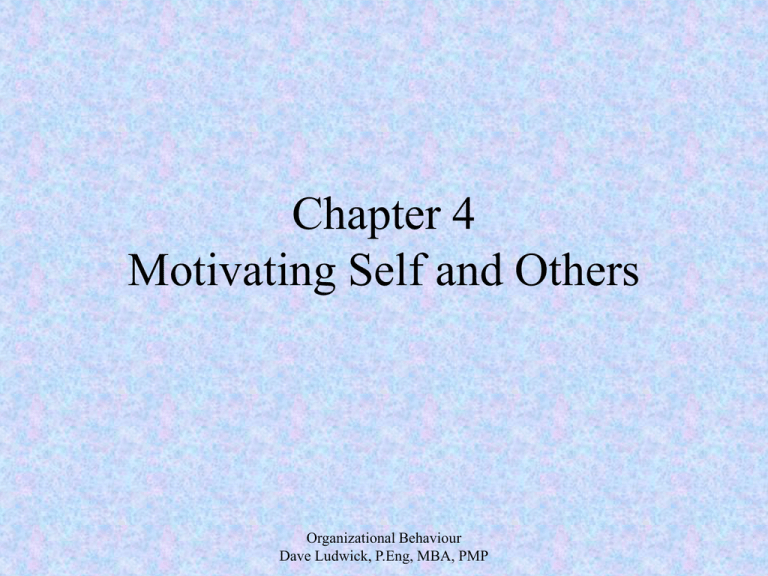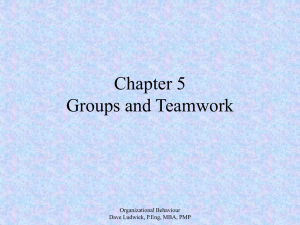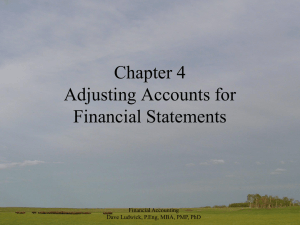Motivating Self and Others
advertisement

Chapter 4 Motivating Self and Others Organizational Behaviour Dave Ludwick, P.Eng, MBA, PMP Motivation • Motivation – are processes that account for an individual’s intensity, direction and persistence of effort toward a goal • Motivation is about getting an individual to consistently take action toward a goal • Lets talk about Theories of Motivation • Then, lets talk about how we can motivate ourselves and others Organizational Behaviour Dave Ludwick, P.Eng, MBA, PMP Theories of Motivation • Theory X vs. Theory Y (Douglas McGregor) • Theory X – emphasizes that employees dislike work, will attempt to avoid it and must be coerced, controlled and threatened with punishment to work • Theory Y – considers that employees will exercise selfdirection and self control if they are committed to the objectives • Robert Shereck suggests – Commitment is what transforms a promise into reality – To commit is to promise to provide something – It speaks boldly of intentions, but actions speak louder than words Organizational Behaviour Dave Ludwick, P.Eng, MBA, PMP Theories of Motivation • Motivators are instruments that incline individuals to act • Extrinsic motivators (Theory X) come from outside an individual. Examples are pay, bonuses and other rewards • Intrinsic motivators (Theory Y) come from an internal desire to do something, motivated by interest, challenge and satisfaction Organizational Behaviour Dave Ludwick, P.Eng, MBA, PMP Needs Theories of Motivation • Need’s Theories describe the types of needs that must be met to motivate individuals • Maslow’s Hierarchy of Needs – Hypothesized that in every person there is a 5 level hierarchy that described a person’s motivations • Motivation-Hygiene Theory (Frederick Herzberg) suggested that motivators (like achievement, recognition, etc) needed to be present to motivate. Hygiene factors (like work conditions and salary) could not motivate, but could demotivate Organizational Behaviour Dave Ludwick, P.Eng, MBA, PMP Maslow’s Hierarchy of Needs • One of the most well-known motivation needs theories • 5 Level Hierarchy of Needs – – – – – Physiological – need for shelter, protection, food Safety – need for security and protection Social – need for affection, belongingness, acceptance Esteem – self-respect, autonomy, status Self-actualization – growth, achieving potential, fulfillment • Although no need is ever completely met, once a level is substantially achieved, the individual advances to the next level • Generally esteem and actualization are satisfied internally, whereas lower order needs (social, safety, physiological) are satisfied externally Organizational Behaviour Dave Ludwick, P.Eng, MBA, PMP Motivation-Hygiene Theory • Herzberg proposed that Satisfiers and Dissatisfiers at work drive job satisfaction • Motivators generally come from within (desire for achievement, recognition, the work itself, advancement) can provide for satisfaction • Hygiene factors (supervision, work conditions, salary) are generally external. – The presence of hygiene factors cannot provide satisfaction, but can only reduce dissatisfaction – The presence of motivators can provide satisfaction, but their absence cannot lead to dissatisfaction Organizational Behaviour Dave Ludwick, P.Eng, MBA, PMP Expectancy Theory • Developed by Victor Vroom, says that people are motivated when they believe that – Effort will lead to good performance – Good performance will lead to organizational rewards – These rewards will satisfy personal goals • Expectancy – the effort-performance link (how probable that the effort will lead to performance) • Instrumentality – the performance-reward link (whether performing at a given level will lead to the attainment of the desired outcome) • Valence – the rewards-personal goals link (the degree to which the organizational rewards will satisfy personal goals Organizational Behaviour Dave Ludwick, P.Eng, MBA, PMP Goal Setting Theory • The belief that – – – – Developed by Edwin Locke Specific goals increase performance Difficult goals (when accepted) lead to higher performance Constant performance feedback also leads to higher performance Organizational Behaviour Dave Ludwick, P.Eng, MBA, PMP Management by Objectives (MBO) • Emphasizes jointly set goals that are tangible, verifiable and measurable. Following characteristics • Goal specificity – precise statements of specific accomplishments • Participative – managers and employees choose the goals together and agree on how they’ll be achieved • Explicit Time Period • Performance Feedback Organizational Behaviour Dave Ludwick, P.Eng, MBA, PMP Equity Theory • Individuals compare their job inputs and outcomes with those of others and then respond to eliminate any inequities • Employees will compare themselves to people inside and outside the company and with different jobs and at different job levels • Equity Theory suggests employees compare themselves generally to others on 4 moderating variables – Gender – employees compare themselves generally to others of same gender – Length of tenure – Level in the hierarchy of the organization – Amount of education or professionalism Organizational Behaviour Dave Ludwick, P.Eng, MBA, PMP The Role of Money • Money is a motivator but a primitive one • It helps to address the basic hierarchy needs (physiological, safety) • Herzberg’s theory says money is a necessary but insufficient external motivator • Employees need money to address some minimal level of needs, but • Employees have equally said that relationships, job satisfaction, respect and good working conditions are more important • Hiring Wars Organizational Behaviour Dave Ludwick, P.Eng, MBA, PMP Motivating to Achieve Goals • At the end of the day, employees are motivated if there is a link between their personal goals and those of the organization • Employees can also be motivated through recognition programs, variable pay programs or other incentive programs (individual incentive programs, group-based incentive programs or organizational incentive programs) Organizational Behaviour Dave Ludwick, P.Eng, MBA, PMP How do I motivate… • Professionals? – Typically professionals are already receiving a competitive wage, so motivation then comes from job challenge, problem solving, skill-development, opportunities for career development • Contingency Workers (Temporary Workers)? – Permanent jobs, greater benefits, training • Low-skilled Workers? – Very difficult to motivate these workers – Greater benefits and skills, job autonomy • Unionized Workers? – There can be very little room to use pay to motivate unionized workers because of tight pay scales – Training, listening to concerns, skill development and cross training where possible Organizational Behaviour Dave Ludwick, P.Eng, MBA, PMP Contemporary Theories of Motivation • Gung Ho by Ken Blanchard and Sheldon Bowles – Make sure the work is worthwhile – Leave employees in control of how they achieve goals – Cheer each other on • The Power of Belief – Napoleon Hill: • “Anything you can conceive and believe you can achieve can be achieved • With every idea God provides an equivalent means by which to achieve it. – Deepak Chopra • Within every desire, is the seed and mechanics for its fulfillment – Jesus Christ • Ask and you will receive, seek and you will find Organizational Behaviour Dave Ludwick, P.Eng, MBA, PMP Influencing Other People • Be genuinely interested in other people – Sometimes that means giving something up to get what you want. Nature frowns upon the idea of getting something for nothing • Smile • Use the name of the other person often and with enthusiasm. This is like a lullaby to them • Listen attentively first to the other person. – Find out what the other person is interested in. This will make the most intimidating character easy to approach. – Talk in terms of the other person’s interests • Leave room for others to contribute • Managers need to create an environment for motivation – Top down service vs. bottom up service Organizational Behaviour Dave Ludwick, P.Eng, MBA, PMP Enrollment • Enrollment starts from a listening of inclusion and speaking a possibility from that listening that leaves the other person with a possibility that they see for themselves (R. Shereck) • There are 5 Conversations for Enrollment – Background of Relatedness – develops a common understanding – Conversation for Possibility – shares the leader’s commitment to a future possible reality – Conversation for Opportunity – a shared project to translate the possibility into reality – Conversation for Action – an invitation to participate that turns that possibility into reality. Inspires commitment – Conversation for resolving breakdowns – determining what interrupted the commitment – Conversation for Acknowledgement - congratulations Organizational Behaviour Dave Ludwick, P.Eng, MBA, PMP Robbins’ 4 Qs of Motivation • • • • How do you benefit by NOT taking action? How do you suffer by NOT taking action? How do you benefit by taking action? How do you suffer by taking action? • Chapter 5 Organizational Behaviour Dave Ludwick, P.Eng, MBA, PMP











